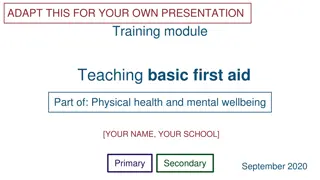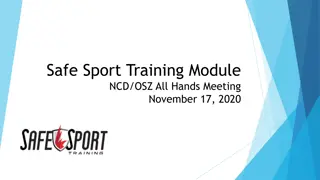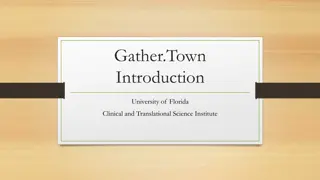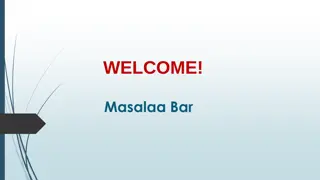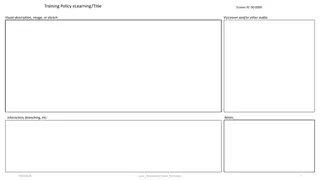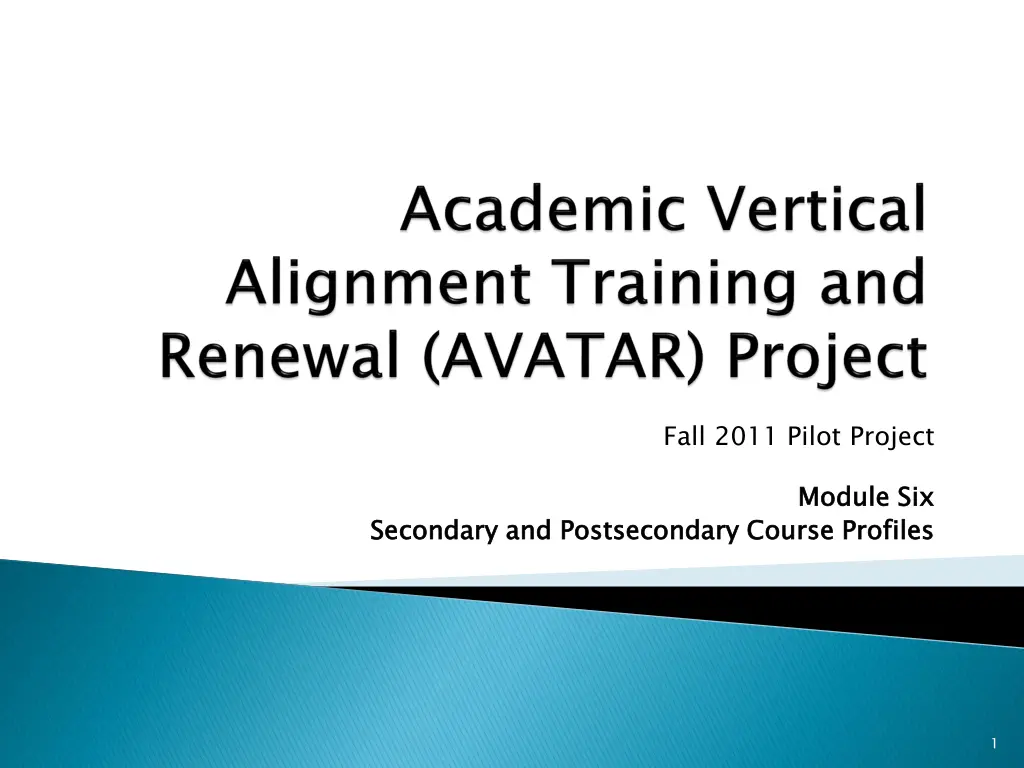
Aligned Course Profiles for Secondary and Postsecondary Education
Explore the creation of aligned course profiles for secondary and postsecondary education, focusing on rigorous standards, relevant curriculum, student achievement, and instructional strategies. The templates provided cover essential knowledge, skills, assessments, and readiness standards, ensuring college and career readiness through cross-disciplinary connections and formative assessment strategies.
Download Presentation

Please find below an Image/Link to download the presentation.
The content on the website is provided AS IS for your information and personal use only. It may not be sold, licensed, or shared on other websites without obtaining consent from the author. If you encounter any issues during the download, it is possible that the publisher has removed the file from their server.
You are allowed to download the files provided on this website for personal or commercial use, subject to the condition that they are used lawfully. All files are the property of their respective owners.
The content on the website is provided AS IS for your information and personal use only. It may not be sold, licensed, or shared on other websites without obtaining consent from the author.
E N D
Presentation Transcript
Fall 2011 Pilot Project Module Six Module Six Secondary and Postsecondary Course Profiles Secondary and Postsecondary Course Profiles 1
Rigorous and Relevant Standards Rigorous and Relevant Curriculum Student Achievement Rigorous and Relevant Assessment Rigorous and Relevant Instruction 2
Creation of secondary course profiles aligned to the Enduring Understandings Key Concepts Texas Essential Knowledge and Skills (TEKS) Texas College and Career Readiness Standards STAAR End-of-Course ACCUPLACER Instructional Strategies Assignments/Activities Resources 3
Creation of postsecondary course profiles aligned to the Enduring Understandings Student Learning Outcomes Texas College and Career Readiness Standards ACCUPLACER Instructional Strategies Assignments/Activities Resources 4
AVATAR Secondary ELA Course Profile Alignment Template Course: Course Description: Enduring Understandings / Essential Questions: Texas Essential Knowledge and Skills (TEKS) Texas End-of-Course (EOC) Assessment Readiness and Support Standards CCRS Cross- Disciplinary Connections Formative Assessment Strategies College and Career Readiness Standards (CCRS) Instructional Strategies Key Concepts Key Terms Resources 5
AVATAR Secondary Science Course Profile Alignment Template Course: Course Description: Enduring Understandings / Essential Questions: Texas Essential Knowledge and Skills (TEKS) Texas End-of-Course (EOC) Assessment Readiness and Support Standards CCRS Cross- Disciplinary Connections Formative Assessment Strategies College and Career Readiness Standards (CCRS) Instructional Strategies Key Concepts Key Terms Resources 6
AVATAR Postsecondary ELA Course Profile Alignment Template Course: Course Description: Enduring Understanding/Essential Question: Texas Texas College and Career Readiness Standards (CCRS) - ELA - College and Career Readiness Standards (CCRS) - Cross-Disciplinary - Key Concepts/Student Learning Outcomes Formative Assessment Strategies Summative Assessment Instructional Strategies Resources 7
AVATAR Postsecondary Science Course Profile Alignment Template Course: Course Description: Enduring Understanding/Essential Question: Texas Texas Texas Key College and Career Readiness Standards (CCRS) - Science - College and Career Readiness Standards (CCRS) - Math - College and Career Readiness Standards (CCRS) - Cross-Disciplinary - Formative Assessment Strategies Summative Assessment Instructional Strategies Concepts/Student Learning Outcomes Resources 8
Enduring Understanding Essential Question Concept Student Learning Outcome Instructional Strategy 9
Statements summarizing important ideas and core processes that are central to a discipline and have lasting value beyond the classroom Synthesize what students should understand not just know or do as a result of studying a particular content area Articulate what students should revisit over the course of their lifetimes in relationship to the content area Enduring understandings: elements as facts and skills demonstrate misunderstandings and misconceptions generalizations and recurrent ideas. Enduring Understanding Example communicated by an author within a print or non-print medium. This is an Essential Question frame the big ideas that give meaning and lasting importance to such discrete curriculum can transfer to other fields as well as adult life unpack areas of the curriculum where students may struggle to gain understanding or provide a conceptual foundation for studying the content area and are deliberately framed as declarative sentences that present major curriculum Reading is a process by which we construct meaning about the information being How is reading a process of constructing meaning from text? 10
Essential questions are important to argue about are at the heart of the subject recur - and should recur raise more questions provoking and sustaining engaged inquiry must become habits of mind when we face real problems often raise important conceptual or strategic issues in the subject can provide organizing purpose for meaningful and connected learning 11
Concepts focus on principles or processes rather than discrete facts or skills. Universal and timeless Applies to more than one time or place or culture Has many layers and nuances, not obvious to the na ve or inexperienced person Yield great depth and breadth of insight into the subject Used throughout K-12 Dig deep to really understand its subtle meanings and implications even if anyone prone to misunderstanding as well as disagreement Likely to change your mind about its meaning and importance over a lifetime Reflect the core ideas in a field or in life, as judged by experts 12
Applicable to new situations within or beyond the content Concept Examples: conflict change migration adaptation place value function Equity 13
More Concept Examples Good triumphs over evil the outsider the more we learn the less we know Nature vs. nurture offense vs. defense America as seen by ourselves, our allies, and our foes; Euclidean vs. non-euclidean geometry freedom involves responsibility no force is acting on a body moving at a fast constant speed form follows function you are what you eat less is more history as a march of human progress anything can be measured if we can identify what it is we want to measure 14
What are the concepts in the Texas Essential Knowledge and Skills (TEKS)? What are the concepts in the postsecondary courses? 15
Statements that specify what students will know, be able to do, or be able to demonstrate when they have completed or participated in a program/activity/course/project. Outcomes are usually expressed as knowledge, skills, attitudes, or values. What are the characteristics of good SLOs? Specify an action by the student that must be observable, measurable, and able to be demonstrated. 16
How can SLOs help students and organizations? Help departments understand how to better facilitate student learning Provide departments with feedback (e.g. Are your services providing what they are supposed to beyond customer satisfaction?) What skills are students learning? Are these the skills we want them to learn? Are these the skills we are teaching them? Enable students to articulate what they are learning and have learned from attending URI, inside and outside of the classroom Help students be able to explain what they can do and what they know Enable students to better understand where they can go to learn particular knowledge, skills, attitudes or values Ultimately, provide students with a map of where various learning opportunities are available throughout the university How can SLOs help students and organizations? 17
Instructional strategies involve techniques, methods, materials, and other means that are used to assist a student to achieve an educational goal. Examples: activating prior knowledge using appropriate reinforcement and practice implementing cooperative learning creating graphic organizers applying efficient note-taking skills Examples: 18
Formative assessment is assessment of how students are progressing in their learning, while summative assessment is a final assessment of learning. Provides checkpoints of student s progress in meeting learning goals Conducted in individual, small group, or large group settings 19
Response cards Hand signals Response boards Oral responses Audience response systems Written summary statements (Exit Ticket) Self assessments Performance tasks Blogs Journals Visual representation Collaborative activities Graphic organizers 20
The future belongs to a very different kind of person with a very different kind of mind creators and empathizers, pattern recognizers, and meaning makers. These people artists, inventors, designers, storytellers, caregivers, consolers, big picture thinkers will now reap society s richest rewards and share its greatest joys. -Dan Pink A Whole New Mind 21
Identify a common concept Concept shared by secondary and postsecondary core learning Define the concept depth and complexity Secondary setting Postsecondary setting Identify the following critical attributes of the teaching of the concept Prior Knowledge Instructional Strategies Activities/Assignments Resources Align concept to the Texas Essential Knowledge and Skills End-of-Course College and Career Readiness Standards 22
Secondary and Postsecondary partners work groups English III English IV Chemistry 23
Three things I learned today. Two ideas I want to know more about. One idea I will use in my teaching next week. 24
If you always do what you ve always done, you ll always get what you ve always got. If you always do what you ve always done, you ll always get what you ve always got. 25

